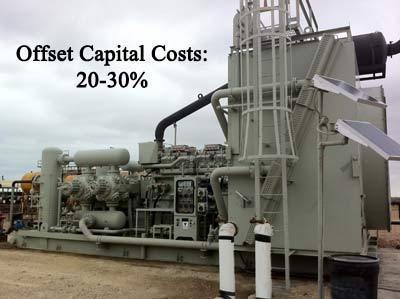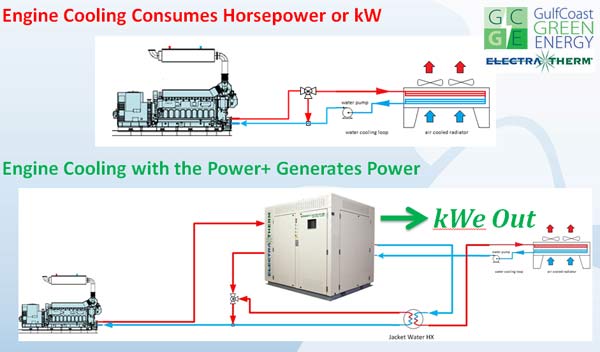Radiator with a Payback
Replace your existing engine radiator with an ElectraTherm Power+ GeneratorTM and generate electricity from the engine cooling process that until now was just an expense and reduced horsepower.
- Offset capital costs: 20-30% of ORC project costs are avoided
- Use a single radiator to free up horsepower, cool the engine, and make new power
- Generate fuel free and emission free power
- Transparent operation & redundancy: Power+ GeneratorTM cools engine even if offline
- Will accept different heat inputs from engine (optimized solution varies per project requirements):
- Jacket Water (JW) + exhaust combined heat input
- JW only heat input
- Separate JW and exhaust
The engine and the Power+ GeneratorTM require cooling.
Satisfy both with one system saving $80,000-$220,000 depending on engine size.
ElectraTherm’s integrated design combines both cooling duties into one radiator to provide 100% full-load cooling capability for the engine, independent of the Power+ GeneratorTM. The Power+ GeneratorTM acts as the engine’s radiator, making it possible to disconnect the engine-driven fans or eliminate the need for a radiator in a new installation. This adds engine torque and makes it possible for the engine to add more H.P. by as much as 20%. By displacing the radiator capital cost and reducing parasitic load, the waste heat becomes a source of cost-savings and energy efficiency.
The robust and cost-effective design of the Power+ GeneratorTM allows turn down ratios of 6:1 available on demand.

Diesel & Gas Turbine Worldwide Magazine featured our “Radiator with a Payback” in the article, “Utilizing Waste Heat for Power”.
“For gas compression, the Green Machine generated electricity can be converted to additional electric powered compressors which adds more gas throughput and increased revenue…all from heat that previously was just wasted. There is an additional value added in emissions-capped areas where another fossil fueled engine cannot be easily added. This is an efficient way stay within air permit levels and increase plant throughput and profitability.”
Click here to read the article in it’s entirety.

